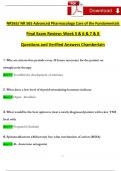Exam (elaborations)
Solution Manual For Contemporary Business Mathematics with Canadian Applications, 13th Edition by Sieg A. Hummelbrunner, Kelly Halliday, Ali R. Hassanlou Chapter 1-16
Solution Manual For Contemporary Business Mathematics with Canadian Applications, 13th Edition by Sieg A. Hummelbrunner, Kelly Halliday, Ali R. Hassanlou Chapter 1-16
[Show more]












